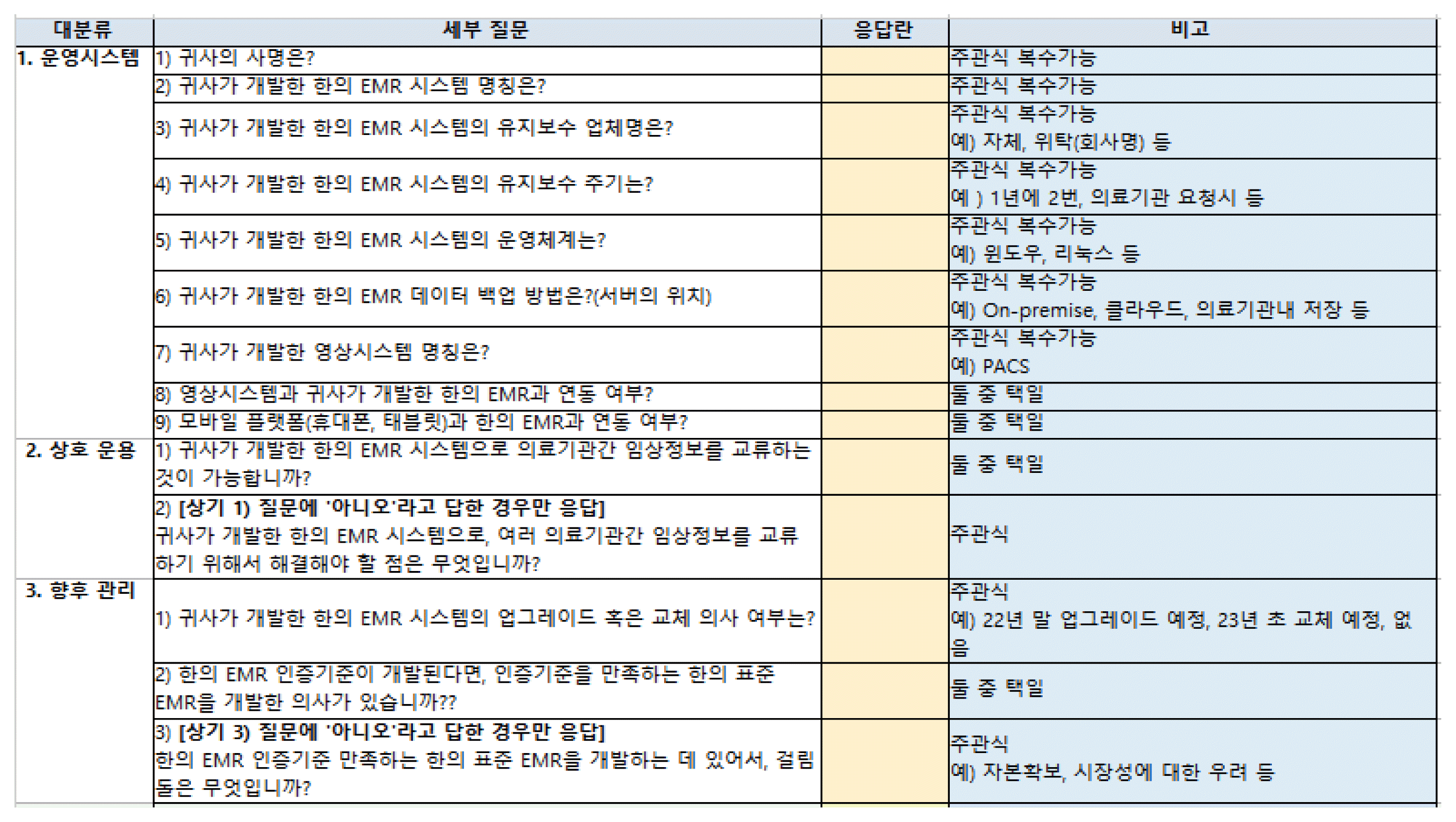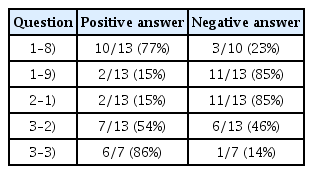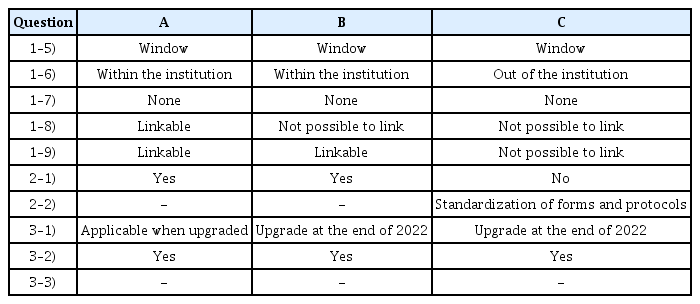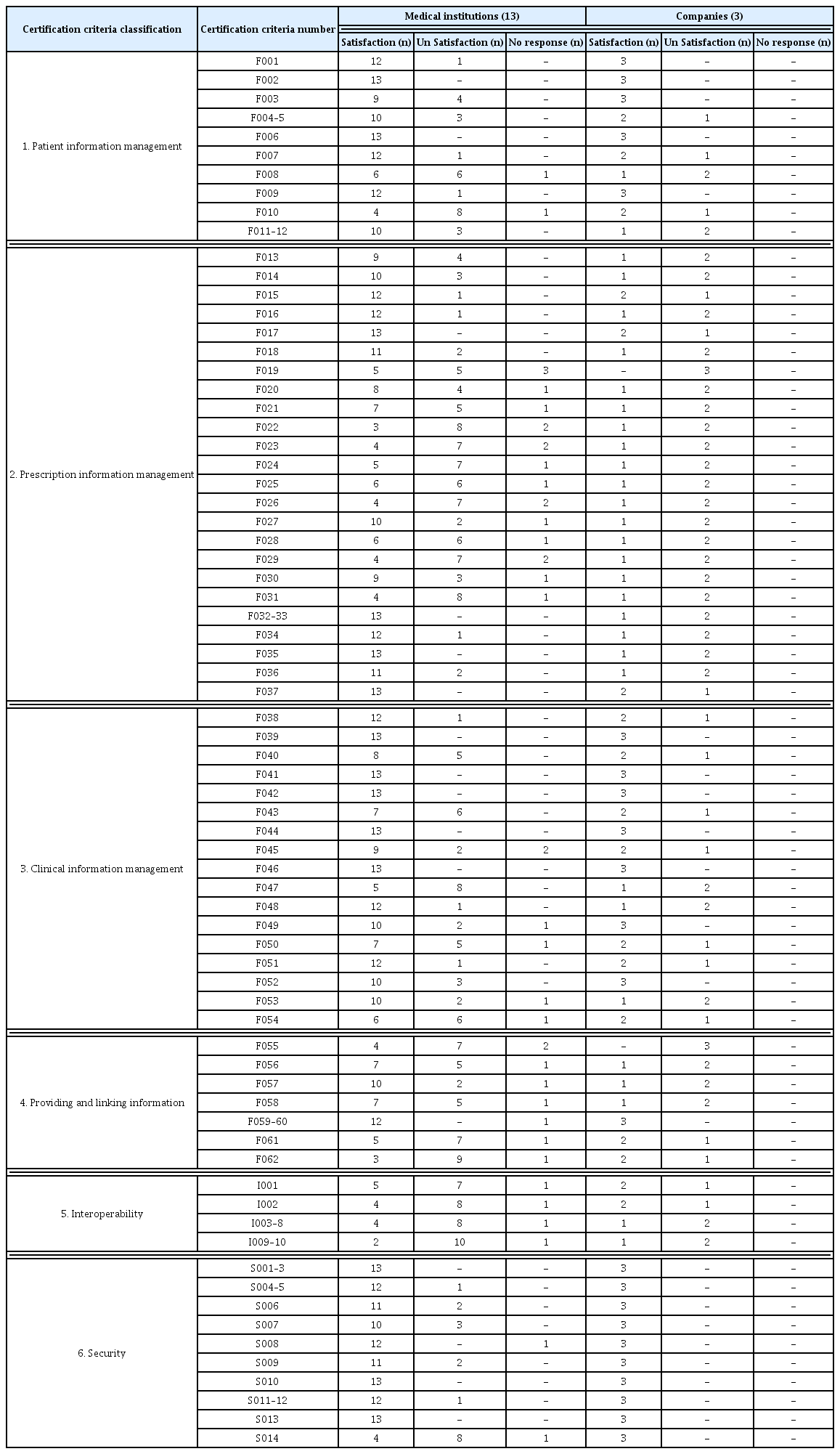A study on the status and applicability of Korean medicine EMR for establishment of Korean medicine standard EMR certification criteria: Through surveys of Korean medical institutions and Korean medicine EMR companies
Article information
Abstract
Objectives
The aim of this study is to explore and investigate the status of EMR currently used in Korean medical institutions and the suitability of the existing certification criteria for Korean medicine EMR certification.
Methods
The survey was conducted using a related questionnaire from September to October 2022. The survey for current status and the suitability of the existing certification criteria was conducted separately between Korean medical institutions and Korean medicine EMR companies.
Results
In a survey of Korean medical institutions on the current status of EMR, more than 80% answered that the imaging system and Korean medicine EMR could be linked. Most medical institutions did not exchange clinical information between institutions. When asked about the intention to develop standard EMR of Korean medicine in the future, 57% of institutions answered ‘yes’. In future, if Korean medicine EMR certification criteria are developed, all EMR companies are willing to develop the EMR that satisfy them. Looking at the satisfaction survey of the existing EMR certification criteria of the Korean medicine EMR system, it was found that high/low satisfaction was shown in various areas, and in particular, the overall clinical information exchange function was insufficient.
Conclusion
In order to introduce the Korean medicine EMR certification criteria, it must be considered of the current status of EMR and applicability of Korean medicine EMR for establishment of Korean medicine standard EMR certification criteria. By developing Korean medicine EMR certification criteria, high-quality medical services can be provided to medical consumers who want Korean medical treatment.
Introduction
Currently, most medical institutions use electronic medical record(EMR) medical charts that are printed on a monitor instead of the previously used paper documents. This is an advantageous form of patient management and information storage compared to the existing handwritten charts and ensures accuracy and transparency in all situations that may occur in medical institutions. [1] In addition, EMRs can be used not only for patient treatment, but also for Western and Korean medicine collaboration [2], or to perform work more smoothly by linking them with other applications using smartphones, tablet PCs, etc. [3] On the other hand, while EMRs have been in use, various issues have been raised, and some systems have gradually developed in a way that complements these problems. Concerns regarding the protection of patient information indicated the need for some modifications [4], and a plan was also proposed to allow patients to directly access information that could previously only be provided by medical professionals. [5] However, because various companies are developing EMRs, applying these amendments uniformly to all EMR systems. Therefore, there is a need for standards that can be applied simultaneously to multiple EMR systems.
In Korea, the Korea Health and Medical Information Service(KHIS) presents EMR certification criteria and grants certification to EMR products and medical institutions that use them. [6] This is to encourage the development of standard products by companies and improve their quality through verification of domestic EMR systems for the purpose of supporting patient safety and continuity of medical care, to ensure that quality medical services can be provided to medical consumers.
In the Department of Medicine, the EMR certification system is implemented in accordance with relevant laws (Article 23, 2 of the Medical Service Act) and enforcement ordinance under the management of the Korea Health and Medical Information Service under the Ministry of Health and Welfare.[7] Additionally, standard framework is being released through EMR System Certification site and training and seminars are being conducted for certification. The most recent revision in the relevant laws and regulations includes the ability for medical institutions to identify patients eligible for medical information provision on July 31, 2023, generate medical information for target patients, and provide medical records to the patients themselves. Four new certification standards were established in the interoperability sector, with effect from October 1. [8]
As for the medical certification standards, the related system is currently being actively operated, with version 1.1 developed in 2020 being applied separately by type and size of medical institutions. However, there is no separate standard for EMR certification for Korean medicine. Therefore, in this study, to develop standard EMR certification standards for Korean medicine and establish a certification system, we aimed to investigate the status of EMR currently used in Korean medical institutions and the suitability of the existing certification criteria for Korean medicine EMR certification.
Methods
1. Subjects
A survey was conducted targeting 13 national Korean medicine institutions and 5 Korean medicine EMR companies, and the EMR data-progressing team manager of each Korean medicine institution as well as and development associates of the Korean medicine EMR companies participated in the survey. Of the 13 Korean medical institutions that requested consultation, 13 (100%) (Figure 1) provided complete responses, while 3 of 5 (60%) Korean medicine EMR companies (Figure 2) provided complete responses.
2. Methods
To investigate the technical characteristics of EMRs used at the target Korean medical institutions, a survey was conducted using a related questionnaire from September to October 2022, and it was conducted by sending consultation request emails to Korean medical institutions and Korean medicine EMR companies and receiving responses. The survey was conducted separately between Korean medical institutions (Appendix 1) and Korean medicine EMR companies (Appendix 2) and was divided into the following three criteria: operating system, interoperability, and future management.
In terms of the EMR operating system, we investigated the name of operating, development, and maintenance systems to understand whether it is on premise or cloud, and whether it is linked to a image system. In terms of interoperability, we investigated if it was possible to exchange clinical information with other medical institutions through the EMR. In terms of future management, we checked whether the companies/institutions were willing to introduce/develop a standard EMR for Korean medicine that satisfies the certification criteria if a Korean medicine EMR standard is developed, and if a standard EMR for Korean medicine was introduced, would they be willing to exchange clinical information with other medical institutions.
In addition, we examined whether certification was possible and reasons for non-certification per the existing EMR certification criteria. “If certification is possible when evaluating the Korean EMR in use according to the applicable certification criteria”, “If certification is not possible when evaluating the Korean EMR in use according to the applicable certification criteria”, and “If no mark is made on the response sheet” were marked as “satisfied”, “unsatisfied”, and “on-responsive”, respectively.
Results
In a survey on the current status of Korean medicine EMRs targeting Korea medical institutions, the name, developer, maintenance company, and maintenance cycle of the Korean medicine EMR system in use at each medical institution were investigated (Table 1). All medical institutions responded that the data backup device was located within the institution (Figure 3), and 10 out of 13 (77%) institutions responded that linking the imaging system and Korean medicine EMR was possible. Although most medical institutions were aware of the benefits of information exchange, 11 (85%) medical institutions were not exchanging clinical information between institutions. When asked whether they exchange clinical information with other medical institutions, the two medical institutions answered “yes” and said that the advantages they are gaining through this are “improvement of patient care” and “improvement of medical quality service through medical information exchange projects.”
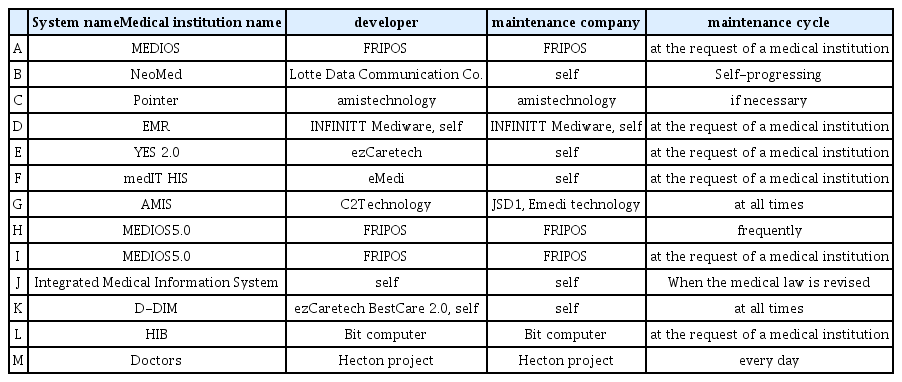
Name, Developer, Maintenance Company, and Maintenance Cycle of the Korean EMR System Used by Each Korean Medical Institution
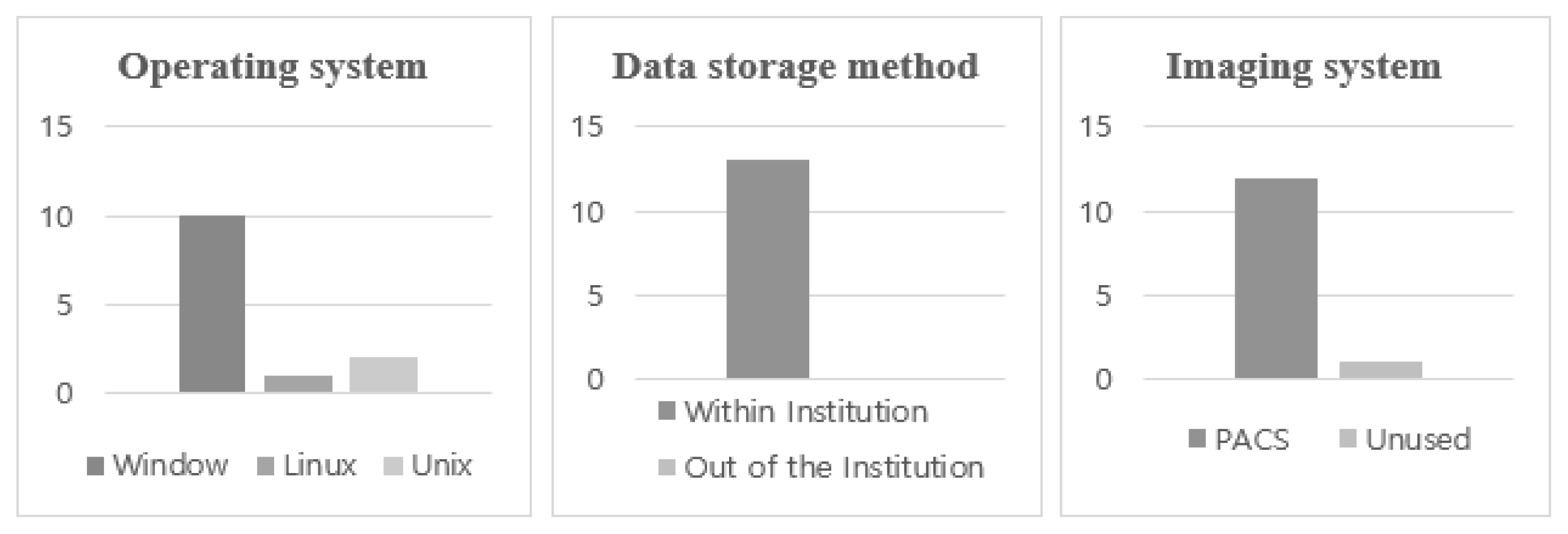
The number of Operating system, data storage method and imaging system of the Korean EMR system used by Korean medical institutions
This is the answer to 1–5) to 1–7) in the Appendix 1 questionnaire.
When asked about the intention to introduce standard EMR of Korean medicine to be developed in the future, the number of institutions that answered “yes” (54%) was only 7, showing no absolute advantage over the percentage of respondents who answered “no”.
Institutions that answered ‘no’ responded with “concerns about information security”, “questions about legal violations”, “concerns about legal liability”, “cost”, and “stability” as reasons for not being able to exchange clinical information with other institutions (Table 2).
In the survey targeting Korean medicine EMR companies, the name, developer, maintenance company, and maintenance cycle of the Korean medicine EMR system developed by each company were similarly investigated (Table 3). Of the three EMR companies investigated, two answered that they store data within the institution and one outside the institution (on-premise), and one and two companies answered that it was possible to link EMR with image systems and mobile platforms, respectively. Two companies responded that exchange of clinical information through EMR was possible, and the companies that answered “no” mentioned standardization of forms and protocols as an issue that needed to be addressed for interoperability. In future management items, all EMR companies said that they are willing to develop a standard EMR for Korean medicine that satisfies the Korean medicine EMR certification criteria if they are developed (Table 4).

Name, Maintenance Company, and Maintenance Cycle of the Korean EMR System Developed by Each Korean Medicine EMR Companies
Looking at the satisfaction survey of the existing EMR certification criteria of the EMR system of Korean medical institutions, most of them showed high satisfaction in “patient information management”, but relatively low satisfaction at 57% and 28%, respectively, in the criteria of F008 (recording and inquiry of consent for surgical procedures) and F010 (displaying information on life-sustaining medical decisions).
In “prescription information management”, treatments common between Korean and Western medicine showed high satisfaction, but the satisfaction level was lower by 10–20% in terms of F019 (record and inquiry of reasons for return when drug administration is stopped), F022 (weight-based drug medication prescription), F023 (calculating pediatric and anticancer drug doses), F026 (notification of medication prescription requiring approval from specific medical department), F029 (calculating administration speed at drug administration), and F031 (safe administration using bar code or radio frequency identification (RFID)).
In “clinical information management”, the satisfaction rate was <50% in terms of F043 (family history record, correction, inquiry), F047 (drug allergy and hypersensitivity information record, correction, inquiry), F050 (recording physical measurements and calculating BMI), and F054 (notification of important test results). It was 14% in the F055 (registration of vaccination information) and F062 (notification of patient health care information) criteria in the “information provision and connection” section, and 42% in F056 (entering a legal infectious disease occurrence report) and F061 (providing customized educational materials).
The satisfaction level was low in all certification criteria (I001 to I001) of “interoperability”, indicating that the overall clinical information exchange function of EMR of Korean medical institutions was insufficient.
Looking at the satisfaction survey on the certification criteria of Korean medicine EMR companies, most of them showed high satisfaction in “patient information management”, but relatively low satisfaction at 33% in terms of F008 (recording and inquiry of consent form for surgical procedures), F011 (registration and inquiry of documents from external medical companies), and F012 (registration and inquiry of external inspection results).
In “prescription information management”, all criteria except F015 (medication prescription recording, correction, inquiry), F017 (refer to previous prescription after change in treatment information), F037 (set (coded) prescription management), F047 (drug allergy and hypersensitivity information recording, correction, inquiry) in “clinical information management”, F048 (drug list inquiry), F053 (Linking Imaging Test Results to Images), F055 (vaccination information registration), F056 (entering legal infectious disease occurrence report), F057 (displaying suspected infectious disease information), and F058 (creating and inquiring suspected infectious disease information) showed satisfaction levels not exceeding 33%.
In the “Information provision and connection” section, F055 (registration of vaccination information), F062 (notification of patient health care information), F056 (entering legal infectious disease occurrence report), F057 (displaying suspected infectious disease information), and F058 (generating and inquiring suspected infectious disease information) showed relatively low satisfaction.
Most of the certification criteria for “interoperability” (I003 to I001) showed low satisfaction, indicating that the overall clinical information exchange function was insufficient, as with EMR of Korean medical institutions. (Table 5)
Discussion
The Korea Medical Information Service encourages the development of standard products by presenting EMR certification standards to provide quality services to medical consumers. In medicine, this certification system is used to make the use of the EMR system easier, and accept feedback after EMR certification to identify complementary points of the certification system.
In this regard, studies are also being conducted by related workers on the perception, limitations, and satisfaction of the EMR certification system.[9,10] In addition, one group is actively conducting research on ways to utilize information more efficiently through linkage between EMR certification and other systems, such as suggesting a development plan to efficiently link the Health Insurance Review and Assessment Service(HIRA)’s review and evaluation system with the EMR certification system and medical information exchange system. [11] By presenting these standards in the Korean medicine community, it is necessary to provide quality medical services to medical consumers who want Korean medicine treatment.
Implementing the EMR certification system of Korean medicine will ensure basic quality of medical information and systems, and make it easier to secure patient safety by acquiring clinical information such as drug allergy history. In addition, compliance with EMR standards will guarantee internal and external reliability of information and improve the quality of medical services by securing interoperability.
Therefore, this study investigated the current EMR status and satisfaction with existing EMR standards for the development of Korean medicine EMR certification standards and the establishment of the certification system in the future, through surveys targeted at users (Korean medical institutions) and developers (Korean medicine EMR companies).
Items on operating system, interoperability, and future management were included in the questionnaire to investigate the current status of Korean medicine EMR system. In addition, the satisfaction regarding the existing EMR certification criteria was confirmed for the Korean medicine EMR system for a total of 86 certification criteria up to F001-S014. Through this, our study provides a foundation for the business related to the EMR certification criteria of Korean medicine in the future.
However, this study had the following limitations. First, this study was conducted on hospital-level medical institutions, but considering the perspective of clinic-level medical institutions should also be added to improve the acceptance of various EMR certification systems. Second, it is necessary to develop components of the EMR certification system, such as certification standards, education, frameworks, laws, and screening systems. Third, it will be essential to secure physical resources (labor costs, research costs, operating costs, etc.) for the spread of the certification system or implementation of the certification system. Fourth, the introduction and management of the certification system should also be established for dedicated institutions and organizations. There are advantages and disadvantages depending on whether the system is incorporated into an existing institution or a new organization is established; therefore, it is necessary to consider various scenarios before implementation.
To introduce the Korean medicine EMR standard, the development of certification standards and the method of introducing the certification system must be considered. Based on the results of the Korean medicine EMR survey conducted in this study, it is necessary to identify items from the existing EMR certification criteria that are currently applicable to Korean medical institution. In addition, it is important to develop certification criteria suitable for Korean medicine EMR by accepting applicable items and deleting or modifying non-applicable items. Furthermore, continuous development and advancement of the components of the certification system are necessary for the settlement and continuation of the Korean EMR certification system. Therefore, related follow-up studies are needed for the development and testing of the approval system, education of users and developers, and training of certification examiners.
Conclusion
In this study, a survey was conducted among 13 Korean medical institutions and 5 Korean medicine EMR companies and all Korean medical institutions and 3 Korean EMR companies completed responses. After the survey analysis, the following results were obtained.
The location of the data backup device was within the institution for all medical institutions, and the imaging system and EMR could be linked in 10 (77%) of them. Eleven (85%) medical institutions were not exchanging clinical information between institutions, and 7 (54%) were willing to introduce Korean medicine standard EMR if developed.
Two (67%) Korean medicine EMR companies stored data in the institution and one stored data on-premise-out of the institution. One company answered that it was possible to link EMR with the imaging system. They answered that exchange of clinical information through EMR is possible in two companies. If Korean EMR certification criteria are developed, all EMR companies were willing to develop standard EMRs that satisfy them.
In terms of satisfaction survey of the existing EMR certification criteria for the EMR system of Korean medical institutions, most of the items on “patient information management” indicated high satisfaction, with “prescription information management” high satisfaction in the items related to common treatment areas between both Korean and Western medicine, but low satisfaction of approximately 10–20% in the items that were not. In terms of “clinical information management”, most items showed less than 50% satisfaction. In all certification criteria of “interoperability”, satisfaction was very low, indicating that the overall clinical information exchange function of EMR of a Korean medical institution, was insufficient.
The satisfaction survey on the certification standards of Korean medicine EMR companies indicated that most of them showed high satisfaction in “patient information management”. In “prescription information management”, many criteria showed satisfaction of up to exceed 33%. It showed relatively low satisfaction in the F055, F062, F056, F057, and F058 in the “information provision and linkage”. Most of the certification criteria for “interoperability” also showed low satisfaction, indicating that the overall clinical information exchange function was insufficient, similar to that observed in the EMR of Korean medical institutions.
Acknowledgement
This study was prepared with support from the Ministry of Health and Welfare’s Korean Medicine Clinical Information Big Data Support Center Construction Project. (090-091-3200-3234-313)
References
Appendices
Appendix 1 A questionnaire conducted on Korean medical institutions
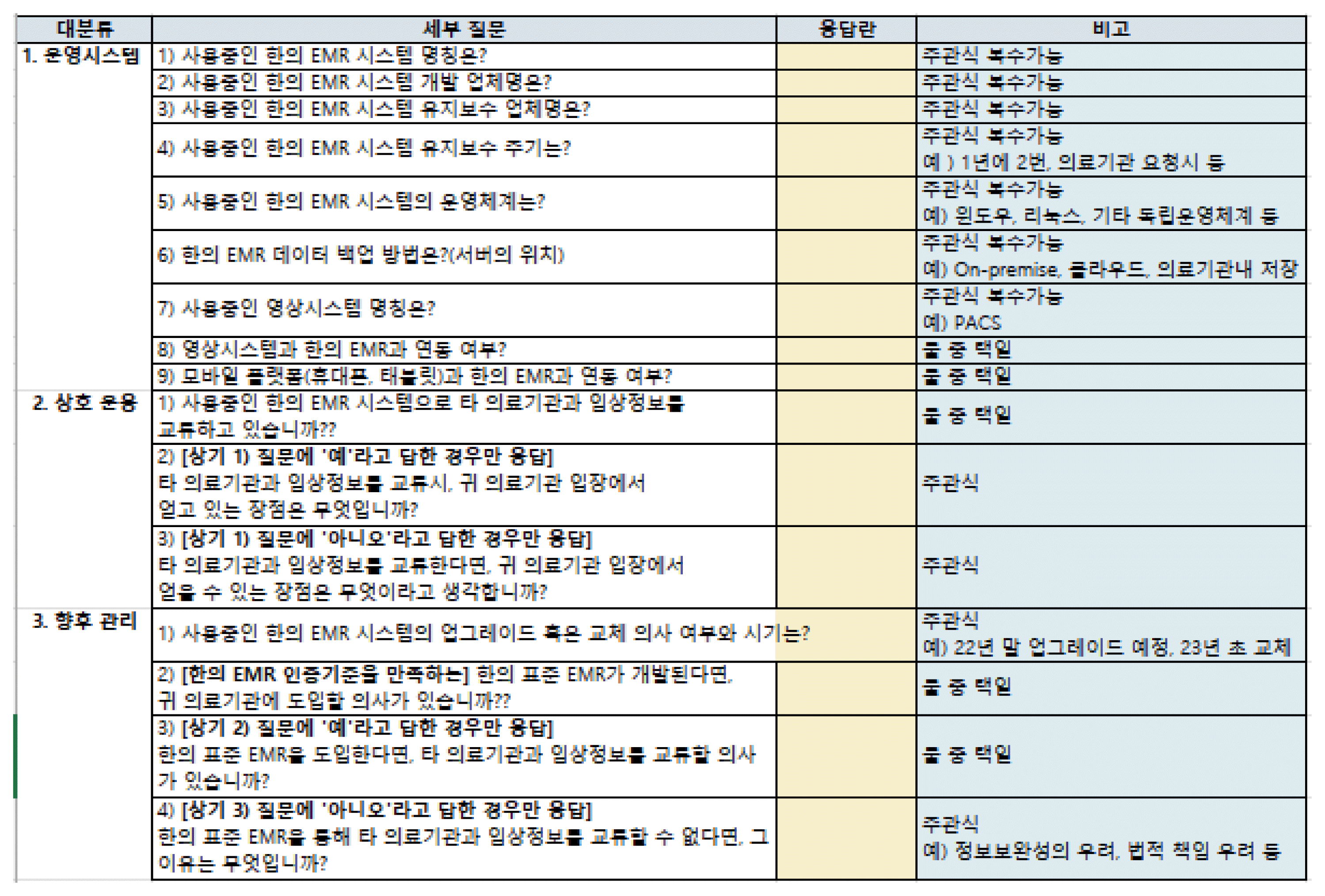
Appendix 2 A questionnaire conducted on Korean medicine EMR companies
